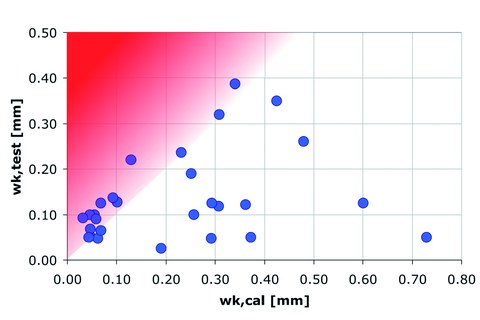Serviceability models in accordance with the German RC Commission Guideline on Steel-Fiber Reinforced Concrete (SFRC)
Table of contents
Project data
|
Titel | Title |
Report in the yearbook 2009
Serviceability of SFRC

Comparison between characteristic cracks in SFRC tests and calculated widths
The need to check the imposed serviceability limit state design requirement arose during the final discussion of verification of the German RC Commission (Deutscher Ausschuss für Stahlbeton, DAfStb) Guideline on Steel-Fiber Reinforced Concrete (SFRC). The goal was to provide independent information and concept tests for approval of the final guideline. Research of mixed reinforced members included control of primary cracking, crack width during crack stabilization, and deflection. Extensive literature research provided useable data from nationally and internationally published research tests which were entered into a database set up specifically for this particular task. In total, the database contains 45 experiments pertaining to primary cracking; 65 experiments pertinent to crack widths in stabilized cracking; and 27 experiments containing information on load-deflection development. In the past, several methods evolved in parallel internationally forming the basis for current characteristic tensile stress-strain-relationships. It was therefore necessary to develop and test some conversion conventions for international SFRC test parameters so as to make comparisons with characteristic values used in the DAfStb-guideline approach.
Results
In a few instances, the amount of reinforcement found in testing for primary crack control was less than calculated values. Measured primary crack widths, for the various classifications tested, were, however, far smaller than limiting crack widths. The primary crack control approach was, therefore, considered to be reliable for the range of parameters researched and tested. There were only a few examples in which the crack widths in externally loaded tests were slightly larger than the respective limits for buildings of 0.3 mm for characteristic values and 0.3/1.8 mm for mean values. Although the methods used to convert the reference strengths might be disputable, the above shows strong evidence that, for this particular available parametric range, this building material ensures reliable serviceability. Results of the short-term verification of deflection for the beams tested showed deflections of less than L/500 under service loads. No test data was available to generally verify larger L/d ratios for slabs.
Research report
Eckfeldt, L.; Lindorf, A.; Lemnitzer, L.: Gebrauchstauglichkeitsmodelle nach DAfStb-Richtlinie Stahlfaserbeton. Forschungsbericht im Auftrag des DAfStb, Institut für Massivbau, Technische Universität Dresden, 2009, 57 pages
